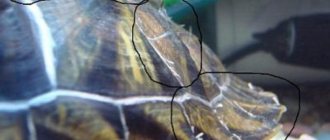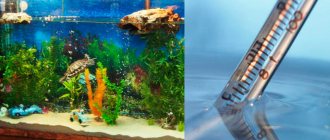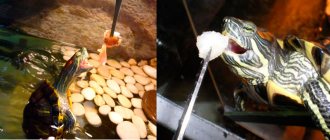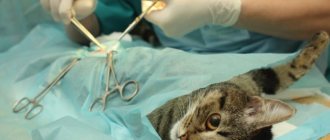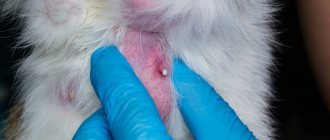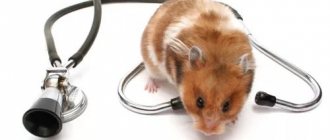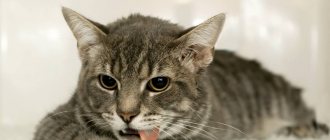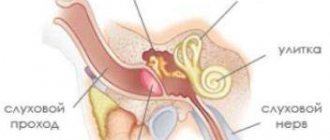Knowledge about the diseases of red-eared turtles when keeping them at home will help you provide the necessary assistance yourself or immediately contact a veterinarian. The experience of specialists shows that it is better not to wait for characteristic symptoms to develop, but to pay attention to the first signs of the disease. They make it quite easy to identify problems and take appropriate action.
To avoid diseases, you must follow certain rules for caring for the red-eared turtle.
Pneumonia
As it turns out, pneumonia can develop not only in humans, but also in turtles. This happens when the reptile’s body becomes hypothermic. The disease is considered serious, and if the pet does not receive timely treatment, there is a risk of death.
Signs of the disease can be noticed within 24 hours after the onset of the inflammatory process. The reptile will be on land or swimming on the surface more often, as it will lose the ability to dive. Pneumonia is treated with medication or using traditional recipes. It is possible to achieve the greatest efficiency only with an integrated approach:
- Intramuscular injections (drugs "Baytril", "Amikacin") are required - consultation with a veterinarian is required, as it is important to determine the exact dosage. If the dose is determined incorrectly, the medicine will not only not help, but can also lead to the death of the turtle.
- Methods of traditional medicine - steam inhalations and warm baths with a decoction of chamomile flowers have a high effect. The reptile is first held over steam and then immersed in liquid for 25-30 minutes. The optimal temperature of the solution for the treatment of pneumonia should not be higher than 30°C.
Signs of illness
The main symptomatic manifestations of turtle diseases:
- the animal stays on the surface of the water for a long time;
- swelling of the eyes, purulent discharge;
- weakness;
- loss of appetite;
- feces with blood;
- white coating;
- shell detachment;
- softness of the shell;
- foam at the mouth.
Another warning sign is a long stay at the bottom of a reservoir, although in some cases turtles may simply fall asleep at the bottom. This will not mean that she has any health problems, but she needs to be woken up and moved to another place, otherwise the animal may die.
If there are any signs of illness, the turtle should be shown to a specialist. Don't put off visiting your doctor.
Eye diseases
If the eyes of turtles are not the weakest point, they still deserve special attention, since diseases of this particular organ often occur. Most often, the owners of these pets are faced with a problem such as redness and swelling of the eyes. In most cases, pathology occurs due to poor or unbalanced nutrition and living in polluted water.
In order for reptiles to avoid such a disease, the following is necessary:
- the redfish menu should include foods containing large amounts of carotene;
- The water needs to be changed regularly.
Eye swelling and hyperemia can be treated at home. A sick reptile is placed in a separate tank, where it will not be able to dive into water on its own. The pet is allowed to swim for 2-3 hours, but the water level should not be such that it is completely submerged.
Complex treatment includes the following activities:
- eyes are treated with a 3% solution of orthoboric acid;
- An ointment containing an antibiotic is applied to the affected organs.
After the swelling and hyperemia go away, food containing a lot of vitamin A is included in the reptile's diet.
Other health problems
It's no secret that each of your pets requires increased attention. The red-eared turtle also needs it. Diseases in these reptiles can be very diverse. For example, in these turtles, you can often notice some kind of mucous discharge coming out of their nose and mouth. The reason for this is viral diseases, as well as a lack of vitamin A. This affects both the cornea and the epithelium located in the nasal cavity.
The next symptom is swelling in the area of the red stripes located on the head, i.e., the “ears”. Most likely it is otitis media. Swellings can be minor (just a few millimeters) or large, measured in centimeters. Frequent causes of otitis media are hypothermia, and less commonly, various types of trauma.
Sometimes you can observe a list in turtles when swimming. There are two versions here: either the reptile ate pebbles, which are abundant in any terrarium, or it fell ill with pneumonia. In the second case, in addition to heeling, there will also be swelling of the eyelids, as well as nasal discharge.
Swelling of the limbs most often occurs with gout. This is a serious disease that should not be neglected under any circumstances, otherwise your pet will die very quickly.
Detachment of horny plates
In reptiles that have a shell, some diseases affect even this strong part of the body. In ordinary life, turtles do not break off parts of the carapace, although when an individual is actively growing, this is also possible.
But with age, the redfish begins to grow more and more slowly. If its plates peel off, the owner should worry - this is one of the reactions to a violation of the conditions of detention. The main reasons for this phenomenon are as follows:
- dehydration;
- damage by pathogenic fungal organisms;
- infection with cyanobacteria;
- deficiency of some vitamin components.
If the shield leaves its rightful place evenly, repeating the shape of the substrate, then we are not talking about serious diseases. You should be concerned if there are a number of signs:
- The plate delaminates, and cavities and small bubbles appear in it . This is a sure sign of a fungal infection. If the inner side of the fallen shield or the surface of the regrown plate is covered with a brown crust or grayish coating, then the possibility of a pathogenic process can be excluded. The point is that fungi can only live on dead tissue. A similar thing is observed when blue-green algae penetrates tissue.
- The shield thickens (hypertrophies), and detachment occurs from the middle, from the deep layers . In most cases, you can save your pet from such a nuisance by adjusting the diet - it must be balanced. Also, the sick turtle is prescribed suitable vitamin and mineral formulations.
- The stratum corneum peels off in the same areas, soft, light spots form. Sometimes under the scutes you can see a fibrous membrane - the periosteum, when wiped with a cotton swab, blood appears. This is a dangerous sign, signaling the development of shell ulcer disease, which English zoologists designate USD. It is caused by pathogenic bacteria.
Therapy for detachment of horny plates includes the following procedures and measures:
- first of all, in case of any violations in the condition of the shell, the conditions in which the reptile is kept should be corrected;
- It is recommended to add a small amount of methylthionium chloride to the water for several weeks until it turns blue;
- for carapace ulcers, in addition to adding blue, it is necessary to use the antifungal drug “Clotrimazole” in the form of an ointment;
- if required, medications with antimycotic effects are prescribed.
It is important to consider that when treating such turtle pathologies, reptiles require some changes in living conditions. It is advisable that they spend the night time on land.
Eye infections
Diseases of the visual organs in red ear are most often diagnosed:
- Conjunctivitis can be caused by dirty water in the aquaterrarium, staphylococci and streptococci. It can also be observed against the background of rickets, pneumonia, and vitamin deficiency. The fact that a reptile has conjunctivitis is indicated by a number of symptoms: the eyes are red, pus is released from them, and the eyelids are swollen. The pet’s general well-being also suffers: it becomes lethargic, does not eat anything, and is indifferent to what is happening. The reptile constantly rubs its sore eyes with its front paws; in advanced cases, the eyes close completely. In case of illness, antibiotics are indicated.
- Panophthalmitis occurs when germs penetrate under the cornea of the eye. This disease causes clouding of the eye and damage to the lower eyelid. Antibiotic therapy is prescribed, and sometimes removal of the eye is required. What to do if this pathology develops should only be decided by a doctor.
Exfoliation of the skin
This condition can occur both during the active growth of reptiles and during the development of various diseases. Detachment of skin flakes also often occurs against the background of mechanical damage or a dermatological disease. In addition, the following causes of peeling skin in turtles can be identified:
- deficiency of vitamin components - vitamins A and group B;
- overdose of vitamins – often occurs when the owner introduces vitamin complexes into the pet’s diet without consulting a veterinarian or does not comply with the recommended dosage. In the case of reptiles, when determining the correct dose, not only the size of the individual is taken into account, but also its species, living conditions and feeding diet.
To understand what caused this symptom, it is advisable to show the turtle to a specialist. He will conduct an examination, diagnose and prescribe a suitable therapeutic regimen, as well as give a number of useful recommendations.
Prevention
To avoid infecting your turtle with infections and diseases, create optimal living conditions for your pet. Control the water temperature and lighting brightness. Keep your terrariums clean. Provide the required dose of UV radiation and normal ventilation.
Red-eared turtles should receive a high-quality, varied, fortified diet. To prevent armored diseases, rickets, and vitamin deficiencies, pets should receive calcium and B vitamins (B1, B2, B3, B6, B9, B12) with their food.
Food for turtles
Vegetables and herbs can be given to reptiles only after heat treatment. Feed your turtle fresh, high-quality food. Supplement the diet with vitamin and mineral complexes that are designed specifically for turtles (Eleovit, Intravit, Multivit).
If your turtle gets sick, becomes lethargic, or refuses to eat, contact and consult a veterinarian. Many diseases can be treated in the early stages of their development.
We invite you to join our Zen channel and group on VKontakte or Odnoklassniki, where new articles for pet owners are published.
Similar articles:
- The soft shell of the red-eared turtle: what is the reason?
- Home for a land turtle
- Menu for Achatina
Diseases caused by pathogenic fungi
Often, owners of red-eared and other aquatic turtles are faced with the fact that their pets are covered with spots and a coating that looks like a layer of cotton wool. A similar disease can be found not only in turtles, but also in other aquarium reptiles. Most often, the cause of this symptom is fungi, and to combat them the following actions must be taken:
- treatment of damaged areas with a 1% solution of potassium permanganate, a similar procedure is carried out within 3-5 days;
- additionally, antifungal ointment is applied to the tissue - “Exifin”, “Atifin” and other analogues;
- All items in the aquarium must be disinfected - they will have to be boiled.
Diarrhea
Freshwater animals, as well as humans, may experience disorders of the digestive system. They can be caused by consumption of low-quality and stale food. This disease can also appear as a result of intestinal injury.
Note! Determining the presence of diarrhea is not difficult. During this illness, the turtle may notice liquid or mushy feces, which may have a strong, unpleasant odor.
What to do at home if your pet has diarrhea:
- food intake is limited during the week;
- Every day the turtle must be bathed in warm water;
- the reptile must drink enough water;
- Every day it is necessary to weigh the animal, this is necessary to control body weight.
Bone diseases
Signs of rickets, detachment and softening of the shell appear for the same reasons: due to insufficient absorption of calcium and other elements necessary for this process, as well as due to a deficiency of ultraviolet radiation. The main symptom of the pathology is thickening of the bones, while their structure and shape are disrupted.
It is difficult, but possible, to detect softening of bone tissue at the initial stage. If you carefully observe your pet, you will notice that the turtle has become lethargic and moves less than usual. This is exactly how reptiles with bone problems behave. If the shell has already softened, this is noticeable immediately: initially, the keratinized particles begin to peel off, and then the hard structure of the shield is replaced by a soft one, and perhaps even a change in shape.
You should consult your veterinarian before treating your turtle for bone disease. He will determine the causes of the disease and prescribe appropriate therapy. Most often it consists of taking vitamin and mineral preparations: Eleovita, Intravita, Multivita. If required, treatment is supplemented with other measures.
If you have bone diseases, your pet's diet needs to be adjusted. Redfish are given small fish with bones. In addition, for preventive purposes, it is recommended to place the reptile under a UV lamp, starting with 5-minute procedures, gradually increasing the time.
How to tell if your pet turtle is sick
It is important to constantly monitor your pet.
The red-eared turtle is dangerous to humans because it can be a carrier of salmonellosis, worms or fungus
As soon as any change in behavior, appearance, strange discharge or similar things appear, then you should be wary and take a closer look at it, as usual.
If the owner wants his turtle to be healthy, then he should properly care for it and pay more attention to the behavior of the animal.
Even one illness can lead to others, more severe and dangerous.
Causes
Most often, swollen eyes are caused by the following factors:
- monotonous food;
- keeping an animal in dirty water;
- hypothermia;
- too bright lighting;
- no ultraviolet lamp.
Avitaminosis
If the problem is caused by a lack of vitamin A, then, in addition to swelling of the eyes, peeling of the skin is clearly visible. Also, a cheesy coating may form on the tongue, emitting an unpleasant odor, and trophic ulcers may appear on the skin.
Conjunctivitis
The causative agents of this infectious inflammatory disease are streptococci and staphylococci. Allergies or poor living conditions can trigger the disease.
The inflammation usually affects one eye, but can spread to the other. In a sick animal, the conjunctiva turns red, the eyelids swell, a white purulent coating appears, and the eyes water.
If left untreated, the temperature rises, coordination of movements is impaired, and appetite disappears.
And if not molting, then what?
However, the symptom of turtle shell peeling may indicate other, more serious reasons not related to molting:
- vitamin A imbalance,
- fungal diseases,
- rickets.
The first ailment is characterized by the formation of ulcers, very severe peeling or flaking of the skin. The scutes peel off from the shell (this does not apply to decorated turtles), and even quite large pieces come off.
An indicator of a fungal disease or dermatitis can be prolonged molting. In an amphibian, the scutes are not completely removed, but under them or on the skin of the animal, areas and sores with a pinkish tint form. White spots appear on the shell of a sick animal. The skin in the folds exfoliates and flakes, causing swelling and pimples. The turtle is suffering from severe itching.
Reproduction
How ready an individual is for reproduction is determined by its size. The length of the carapace of a sexually mature male is 10 cm (it is typical for individuals 2-4 years old), females - 12-13 cm (age 2-5 years).
Mating games in these animals begin with the active actions of the male. He turns his muzzle towards the female, swims in front of her and waves his paws. This happens in March and June (if the turtles live in the wild). For a successful pregnancy, it is necessary to be warm. In addition, the female requires increased nutrition.
Shortly before laying eggs, the female looks for a secluded place to lay eggs. This is done on land. A few months later, babies hatch from the eggs. Usually this takes about 2 months, but in bad weather the period of formation of small turtles is delayed. The female does not look after the clutch and does not take part in the life of the cubs.
Lack of vitamin D3, calcium
When a reptile lives in captivity, a lack of calcium may appear in its body. The main factors for this disease are considered to be poor nutrition with low calcium levels, as well as a lack of ultraviolet radiation.
Main symptoms:
- in young individuals the shell does not harden. Its complete hardening should occur by the end of the first year of life;
- deformation of the shell, paws, jaw;
- in older reptiles, the shell may become soft, and its back part may collapse;
- the surface of the shell becomes light and flat;
- beak deformation;
- brittle bones;
- accumulation of fluid in the plastron scutes;
- the formation of mucous secretions on the skin, it may become sticky.
It is advisable to immediately consult a doctor if these symptoms occur. The specialist will conduct an examination and prescribe the necessary treatment therapy. This disease can be cured, the main thing is to follow all the veterinarian’s recommendations.
Features of behavior
It is quite difficult to interact with these pets. They have a slippery body, the animals tend to hiss and resist. The presence of sharp claws creates even more difficulties. An unhappy turtle can bite painfully, so you need to handle it carefully.
It is better not to handle small reptiles at all. They don't cause as much trouble as adults, but they are very afraid of being touched, which can cause them to become stressed and get sick. If they were recently introduced into the aquarium, you should not approach them too often, look at them, or knock on the glass.
Aggression can often be seen in the behavior of these animals. In relation to individuals of other species, they try to take a dominant position. They get into fights, biting and scratching, leaving quite serious wounds. Males tend to attack females, and these attacks can result in serious injury and even death. It is especially risky to introduce new individuals into an already formed terrarium. The adult red-eared turtle prefers solitude, and it is best to take this into account.
If you have a red-eared turtle at home, you need to find out why it is dangerous for the child. Some people mistakenly consider these animals to be harmless, but if you take into account the peculiarities of their behavior, you can understand that this is not the case. The pet's tendency to aggression requires careful interaction with it. Bites can be very painful for children, as can injuries caused by claws.
But the most important thing that makes such a reptile dangerous for a child is its ability to carry certain diseases, such as salmonellosis, fungal infections, and helminth infections.
Caring for a turtle during molting
Usually , molting does not need treatment - it is not a pathology. But suddenly it seems to you that your pet feels uncomfortable, then you can try to make her life easier.
There is no need to change the tortilla's daily routine. First of all, you should review your diet. During molting, the amphibian needs a much larger variety of vitamins, as well as calcium.
Add vitamins to your diet. The turtle's menu can be enriched with fish fry or small crustaceans - they contain calcium.
You can increase the content of essential vitamins by using special vitamin complexes. Thus, the vitamin complex “Eleovit” has proven itself well.
It is administered in the form of injections: two injections, leaving two weeks between them. You can repeat it no earlier than six months later.
The second important point is the sanitary condition of the aquarium where the amphibian lives. It is clear that during molting, aquarium water becomes contaminated with many small dead particles of skin and shell, and these “little things” tend to rot, which should not be allowed: the water should always remain clean.
Cleaning from husks. It happens that turtle owners try to help their pet clean exfoliated tissue from its shell.
This can be done only when it is clearly noticeable that the scales do not fall off on their own and the pet feels discomfort from this.
Then the dead tissue should be carefully cleaned off with a toothbrush - in order to avoid complications, because... the amphibian, trying to shed molted scales, is capable of scratching its skin until it becomes ulcerated.
It is recommended to bathe land turtles in warm water, adding a teaspoon of baking soda to 1 liter. And you shouldn’t get carried away with this either: twice during the entire molting period is enough.
Aquarium content
Temperatures for baby red-eared turtles should be different from their adult counterparts. For land it is 32 degrees Celsius, and for water - no more than 26 degrees Celsius . Choose a long aquarium that is not very wide and tall. The volume of water must be at least 120 liters. Adjust the water level according to the proportions of the turtle's shell. It should be able to roll over. At the edge of the aquarium, arrange a land shore in the form of an island. Such an island can be purchased at pet stores, or you can build it yourself.
The water must be constantly cleaned. Special filters are sold for this purpose. If there are only young turtles in your aquarium, then use an external filter, and if they are already adults, use an internal one. An additional device can be used with an ultraviolet lamp, which must be placed at a height of up to 25 centimeters. Incandescent lamps are suitable for heating water and sushi. Turn off all lamps at night. Please note that the lamps may be splashed with water, so they should be hidden from moisture and evaporation. When the weather is good, it is a good idea to take the aquarium out onto the balcony to warm up, but no more than 5 minutes for the first time. Increase the time spent in the open space gradually as the turtles need to get used to it.
